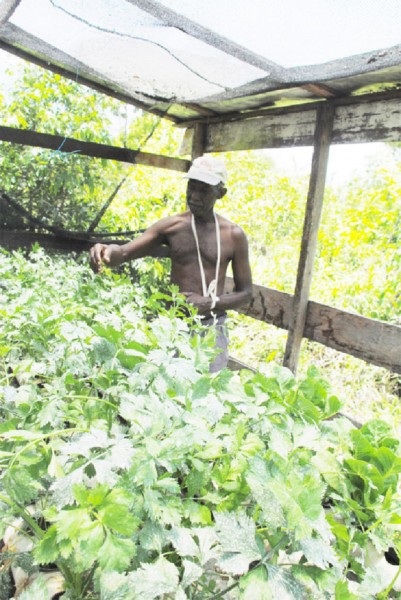Fitzroy Valentine is one of the more than 60 members of the Mar Friends Cooperative Society who have been cultivating crops on land bordering Cuffy Dam at Friendship, East Coast Demerara for more than 30 years.
Valentine, a Buxtonian and an experienced farmer, has been influenced by the Partners of the Americas’ Farmer to Farmer programme which appears preoccupied with spreading the message of hydroponic farming in Guyana.

The evidence on his farm suggests that Valentine’s pursuit of agriculture and agro-processing has taken several twists and turns and that he has arrived at a point where he is acutely aware of the virtues of pursuing hydroponics as a commercial venture.
Over time, he has accumulated a collection of assorted relics; the now-disused evidence of experiments with agro-processing of one sort or another. There was time, too, when he operated a thriving orchard, cultivating mostly cherries and guavas for the manufacturing sector. He attributes the decline of this venture to changing weather patterns.
Most of the farms comprising Mar Friends Cooperative Society along the earth road named Cuffy Dam appear hemmed in by dense overgrowth; vegetation that can only be removed and suppressed by constant attention utilising machinery that does not appear to be in evidence in the community. The thicket appears to confine farming to limited spaces carved out of the wider jungle which is only kept at bay by dint of perseverance.
Valentine embraces rather than rejects the walls of dense greenery that hem him in. He points to each seemingly wild plant and volunteers a lecture on its medicinal or commercial value. Then he gestures to one of his many artifacts, which had once been used to extract oils from one plant or another.
Once you get past the walls of green and arrive inside the clearing that is Fitzroy Valentine’s farm you recognise immediately that he is a keen and ambitious student of hydroponics. There are large shadehouses where mostly lettuce, celery and bell peppers are under cultivation. The lettuce and bell peppers are planted in neat rows, their roots, held in place by ‘soil’ comprising paddy shell and sand. The plants are thriving despite the sweltering heat. The temperature, Valentine assures us, is bearable.
The celery is being cultivated in in another shadehouse, the roots immersed in water provided by a network of PVC pipes. Small clumps of pebbles anchor the roots of the celery. The leaves are dotted with a whitish substance that appears to have dried there. It is, Valentine says, a mix of chalk and water, used to deter a fly that threatens the survival of the celery.
Our visit is not a timely one. Valentine’s farm is undergoing a transformation. He is rehabilitating the shadehouses and in the process he has discarded some vegetables under cultivation. In the instance of one of the larger shadehouses he has uprooted more than 90 head of lettuce from the sand and paddy shell and deposited them on the ground nearby. The discarding of the vegetables is testimony to the vagaries of a market for hydroponic vegetables which is still erratic.
Valentine’s vegetables are delivered to various business establishments in the city and elsewhere. He also provides a delivery service to several urban and rural households. “It’s good business,” he says.
For the time being his quest to transform his farm has been slowed by an injury to his hand. His vision for the enterprise, however, is clear. He wants to continually improve the quality of his seed material and to help refine a market that is still unstable. Like other hydroponics converts, Valentine believes that the pursuit has huge commercial potential. He believes that you can actually taste the difference in hydroponically grown vegetables.
Valentine’s awareness of the steadily growing family of hydroponic farmers is a source of optimism. He believes that inhospitable weather conditions and environmental risks associated with the excessive application of chemicals to plants grown in soil will enhance farmer awareness of the virtues of hydroponics. “Seeing is believing,” he says. By that he means that successful shadehouse projects can be used as laboratories that will enable visitors to see the technology at work.





